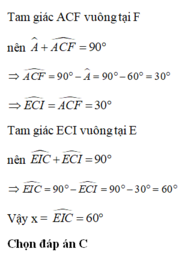

Hãy nhập câu hỏi của bạn vào đây, nếu là tài khoản VIP, bạn sẽ được ưu tiên trả lời.



Với mọi x thuộc R Có (x^2-9)^2 \(\ge\) 0
[y-4] \(\ge\) 0
Suy ra (x^2-9)^2+[y-4] - 1 \(\ge\) -1
Xét A=-1 khi và chỉ khi (x^2-9)^2 và [y-4] đều bằng 0
Tự tính ra
Xin lỗi nhưng vì không biết nên mình phải dùng [ ] thay cho GTTĐ nhé
Xin lỗi nhiều tại mình o tìm được kí hiệu đó

\(a,x^2-113=31\\ \Leftrightarrow x^2=144\\ \Leftrightarrow x=\pm12\\ Vay...\\ b,\sqrt{x+2,29}=2.3\\ \Leftrightarrow x+2,29=6^2\\ x=36-2,29=33,71\\ c,x^4=256\\ \Leftrightarrow x=\pm4\\ Vay...\\ d,\left(\sqrt{x}-1\right)^2=0,5625\\ \Leftrightarrow\sqrt{x}-1\in\left\{-0,75;0,75\right\}\\ \Leftrightarrow\sqrt{x}\in\left\{0,25;1,75\right\}\\ Vay...\\ e,2\sqrt{x}-x=0\\ \Leftrightarrow\sqrt{x}\left(2-\sqrt{x}\right)=0\\ \Leftrightarrow\sqrt{x}=0hoac2-\sqrt{x}=0\\ \Leftrightarrow x=0hoacx=4\\ f,x+\sqrt{x}=0\\ \Leftrightarrow\sqrt{x}\left(\sqrt{x}+1\right)=0\\ \Leftrightarrow x=0hoacx=1\)
a. x2−113=31
=> x2=144
=> x2=\(\sqrt{144}\)
=> x=\(\pm12\)
c.x4=256
=> x4=44
=> x=\(\pm4\)

bài 1 : a) oh là tia đối oz \(\Rightarrow\) zoh thẳng hàng
ot là tia đối của tia ox \(\Rightarrow\) xot thẳng hàng
ta có : xoz = \(\dfrac{100}{2}=50^0\) (oz là tia phân giác của góc xoy)
mà xoz = toh (đối đỉnh) \(\Rightarrow\) toh = 500
b) ta có : toh = xoz (đối đỉnh)
mà toh = 400 \(\Rightarrow\) xoz = 400
\(\Rightarrow\) xoy = 40.2 = 800
bạn ơi tớ bảo phần ab bài 1 tớ biết làm rồi tớ muốn cậu có thể giúp tớ bài 2 và bài 3,bài 1 c,d được không
xin cảm ơn các bạn trước!

a) Căn cứ các kí hiệu đã cho trên hình của bài 39 ta có: ∆ABD và ∆ACD có:
AB = AC
ˆBAD=ˆCADBAD^=CAD^
AD là cạnh chung
=> ∆ABD = ∆ACD
b) Vì ∆ABD = ∆ACD
=> BD = CD => ∆BCD cân tại D
=> ˆDBC=ˆDCB
Hướng dẫn:
a) ∆KIL có ˆII^ = 620
nên ˆIKL+ˆILKIKL^+ILK^ = 1180
Vì KO và LO là phân giác ˆIKLIKL^, ˆILKILK^
nên ˆOKL+ˆOLKOKL^+OLK^= 1212(ˆIKL+ˆILKIKL^+ILK^)
=> ˆOKL+ˆOLKOKL^+OLK^ = 1212 1180
ˆOKL+ˆOLKOKL^+OLK^ = 590
∆KOL có ˆOKL+ˆOLKOKL^+OLK^ = 590
nên ˆKOLKOL^ = 1800 – 590 = 1210

c) Vì O là giao điểm của hai đường phân giác của ˆKK^ và ˆLL^ nên O cách đều ba cạnh của tam giác IKL

Đặt \(\dfrac{a}{b}=\dfrac{c}{d}=k\) \(\Rightarrow\) \(\begin{cases} a = bk \\ c = dk \end{cases}\)
Ta có: \(\dfrac{a^2+c^2}{b^2+d^2}=\dfrac{b^2k^2+d^2k^2}{b^2+d^2}=\dfrac{k^2\left(b^2+d^2\right)}{b^2+d^2}=k^2\left(1\right)\)
\(\dfrac{a.c}{b.d}=\dfrac{bk.dk}{b.d}=\dfrac{k^2.b.d}{b.d}=k^2\left(2\right)\)
Từ (1) và (2) suy ra: \(\dfrac{a.c}{b.d}=\dfrac{a^2+c^2}{b^2+d^2}\) \(\rightarrow đpcm\).

Vì \(b\ne d;b+d\ne0\) nên áp dụng tính chất cảu dãy tỉ số bằng nhau ta có:
\(\dfrac{a}{b}=\dfrac{c}{d}=\dfrac{a+c}{b+d}=\dfrac{a-c}{b-d}\)
Vậy \(\dfrac{a+c}{b+d}=\dfrac{a-c}{b-d}\) (đpcm)
Chúc bạn học tốt!!!
Ta có:Nếu
\(\dfrac{a+c}{b+d}=\dfrac{a-c}{b-d}\)
thì \((a+c)(b-d)=(a-c)(b+d)\)
\(a(b-d)+c(b-d)=a(b+d)-c(b+d)\)
\(ab-ad+bc-cd=ab+ad-bc+cd\)
\(=\)\(ab-ab\)\(-ad+ad\)\(+bc-bc\)\(-cd+cd\)
\(=0\)
\(\Leftrightarrow\left(a+c\right)\left(b-d\right)\)\(=\left(a-c\right)\left(b+d\right)\)
\(\Leftrightarrow\dfrac{a+c}{b+d}\)\(=\dfrac{a-c}{b-d}\)